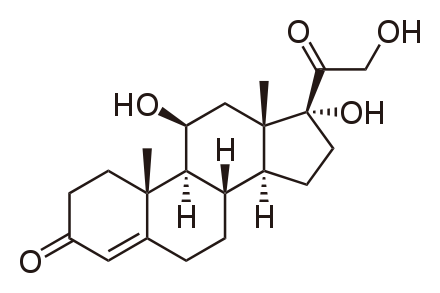Cortisol and Stress
Cortisol, commonly known as hydrocortisone, is the major hormone secreted by the adrenal glands when the body is under stress. It is critical in the body’s ability to act accordingly when attacked, whether it is by invaders like viruses and bacteria or allergens, or perceived attacks such as stressful jobs, relationships, and a toxic environment. The body does not know whether it’s a dangerous infection or a toxic emotional environment, it just knows that you are in trouble and the response is the same. The body secretes cortisol to mobilize glucose so you can run fast and think quickly. It increases epinephrine (also known as adrenaline) and norepinephrine output so your heart can beat faster and increase your blood flow to your muscles, brain, and heart. It is a catabolic hormone and will break tissue down (bone, muscle, liver) and utilize glucose production and stores to assure adequate fuel to keep you functioning at a higher level. Cortisol dampens the immune system so the immune response is not overzealous and destructive.
Robert Sapolsky’s book “Why Zebras Don’t Get Ulcers ” describes and helps us understand the stress response. In a nutshell, when a zebra is being chased by a tiger, his cortisols shoot up and he has what he needs (hopefully and if not, it’s all over anyway) to run fast and think quickly to escape the tiger. When the chase is over, the zebra goes back to eating grass and his cortisols go back to stable levels until the next danger arises. Sapolsky draws on “The Stress of Life” (Hans Selye‘s classic) and Selye’s research with rats in a stress-induced environment to illustrate how our bodies respond in high-stress situations – it’s not depletion or exhaustion, but the stress response itself that causes the body to break down in the end. Essentially, in our stressful lives, many of us are constantly being “chased by the tiger”. Our cortisol output is chronically elevated which can lead to abnormal glucose metabolism and elevated blood sugar, hypertension, sleep disarray, thyroid dysfunction, decreased bone mass, decreased muscle mass, lowered immunity, and weight gain particularly in the abdomen. After years of chronically elevated cortisol output, the communication between the brain and adrenals gets a bit skewed, and the cortisol output can be too low and/or secreted at inappropriate times, i.e. at 3 AM when it should be low, leading to insomnia. The adrenals eventually can’t sustain the high cortisol levels. When adrenal output starts to fall, the result is fatigue, depression, apathy, increased respiratory infections due to compromised immunity, and a generalized decrease in well-being.
Cortisol is King
Cortisol is essential to life. Without cortisol, one has Addison’s Disease (like John F. Kennedy), or adrenal failure and must take cortisol to survive. Because it is essential, all the hormones “defer” to cortisol. The thyroid needs cortisol to govern its function. The production of progesterone, estradiol, testosterone, DHEA, pregnenolone: all hormones of the steroid hormone cascade, will decrease and shunt the pathway to favor cortisol and assure adequate levels of this essential hormone.
The Sands of Time
As men and women age, their hormone reserve and ability to produce hormones declines with levels decreasing to <50% of the levels of a 20-year-old. For women, menopause brings about an increased demand on the adrenals because the ovaries’ production of progesterone falls precipitously and are no longer able to support the production of cortisol. In fact, as the ovaries fail, the adrenals are now also responsible for taking over reproductive hormone production. Menopause can be devastating for women with adrenal dysfunction. For men, the decline in testosterone, while generally slower without an acute dip, contributes to the symptoms of adrenal insufficiency resulting in accelerated aging and the “grumpy old man” syndrome that we now call andropause.
Decreasing stress and learning how to relax
Lifestyle changes are essential to restore healthy adrenal function. A high protein, low glycemic diet along with replacement of essential nutrients helps to manage blood sugar, fatigue, and immune function. Many complementary therapies such as guided imagery, hypnosis, exercise, yoga, breathing relaxation techniques, and meditation can normalize the stress response and help the adrenals to heal. For those with severe deficiencies, low doses of bio identical hydrocortisone can help in restoration and rest for the adrenals. If the cortisol deficiency is significant, the replacement of other hormones may not provide relief of symptoms until cortisol is also replaced.
Bio identical hormone replacement is not complete until the adrenals and cortisol issues are addressed. Evaluating adrenal function with diurnal saliva cortisol levels is an essential piece of bio identical hormone replacement therapy.
For more information on saliva testing, adrenal dysfunction and adrenal fatigue, see http://www.adrenalfatigue.org/what-is-saliva-testing.html




[…] to be a contributing factor. Cortisol, another essential hormone which we will discuss in a later post, is also necessary for the thyroid to function optimally. Low or high cortisol is associated with […]
[…] in the hormonal cascade and is a precursor for all the other steroid hormones: progesterone, cortisol, estradiol, testosterone, and DHEA. Like the other steroid hormones, pregnenolone declines […]
Keep up the good work on this blog!
Right on!
I am not certain where you’re getting your information, but great topic. I must spend a while studying more or working out more. Thank you for magnificent info I used to be searching for this info for my mission.
[…] Stress […]
[…] Cortisol and the adrenals play a big role in CFS. The role seems to be more a result of a hypothalamic pituitary axis (HPA) dysfunction/communication rather than a clear result of low cortisol. Because cortisol is essential to life and abnormal cortisol affects many other hormonal systems, it is essential to address the function of the HPA axis. Adrenal fatigue, or burnout, is actually quite common. This article explains and describes the symptoms nicely. […]
[…] Endocrine problems, menopause and andropause […]